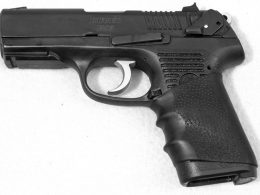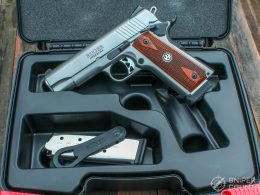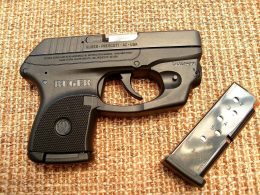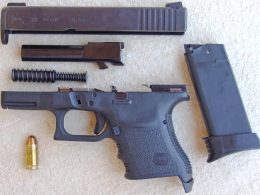In this Article:
OK, boys and girls…set your Way-Back machine for 1985. Point it to Southport, Connecticut – the Ruger factory there. As you enter the Ruger administrative offices, you may notice several men and women “high-five-ing” each other. Why? They had just introduced a new line of pistols, to compete in the marketplace against other “wondernines†and were extremely confident in its success.
So…what was so great about what came to be called the P series of Ruger pistols? Well, the first one had an alloy frame, held 15 rounds of 9mm ammo and was a double-action/single-action (DA/SA). Those pistol specifications weren’t exactly new or rare back then, but the lower cost was certainly welcomed…this was a gun that most any average shooter could afford.
The P Series History
Ruger heard that the military was looking to adopt a new handgun to replace all those old 1911s and revolvers carried by our service men and women. Designed for the X10 military pistol-adoption trials in 1985 but not really out until later, the P85 was a bit late to the dance and so was not in the running for the trials. So, Ruger (like other manufacturers) decided to sell the gun on the civilian and law enforcement markets. In order to not have this review run to exhorbitant lengths, let’s take a quick look at the P series of guns and their salient features…
P85/P85 Mk II (1985-1992)
This was the great-great-grandpappy, the paterfamilias, of the P series guns. Designed as mentioned above with an aluminum frame, DA/SA trigger, decocker and manual safety, it became available starting in 1987. The gun was a good seller at the then-low MSRP of only $295. Police agencies and civilians bought them in good numbers.
In 1989, the gun was re-issued as the P85 Mk II. This name meant that the gun had had a new firing pin block installed that would not allow the hammer to contact the firing pin upon decocking. This stemmed from one incident where a pistol with a damaged firing pin fired when it was decocked using the lever made for that purpose. Ruger recalled the guns and fixed them. (If you have an unmodified P85, you might want to contact Ruger to see if yours needs a trip home for the cure). The “Mk II†on the slide means that the gun has been modified by Ruger. Other upgrades included better accuracy and larger safety levers.
P89 (1992 – 2009)
In 1992, the P89 was introduced. It was basically an upgraded P85 with an investment-cast aluminum frame, with a DAO variation added. In that same year, Ruger debuted the P89X, which included an extra barrel and recoil spring for the .30 Luger cartridge. Fewer than 5,800 of these guns were made in 1994, the only year of production. The P89 is one of the most popular P series guns around, according to sales records.
P90 (1991-2010)
The P90 was Ruger’s first attempt at making a .45 ACP pistol. It was basically a size-upscaled P89 and was meant to be in competition with the S&W 4500 series and the SIG Sauer P220 (and, to a lesser extent, the Glock 21). It was produced until 2010.
P91 (1992-1994)
Basically the P91 was a P89 chambered for the .40 S&W cartridge – it was made for two years.
P93 (1994-2004)
The P93 was a compact, 3.9-inch-barreled version of the P89. It was designed in 1993 but was not released until the next year. It used most of the features of its parent gun, but used a simpler, easier-to-produce frame. Capacities were either 15 or 10 rounds. It was made until 2004.
P94 (1994-2004)
The P94 was a mid-sized version of the P93. Introduced with its smaller cousin in 1994, it featured different grips and a 4.3-inch barrel. It was made alongside the P93, with both models being discontinued in 2004.
P95 (Introduced in 1996 with some models being discontinued between 2004-2013)
The P95 was a game-changer for Ruger. Sporting the shorter 3.9-inch barrel, this was the first “P†gun to have a frame made not of alloy but of a Dow Chemical polymer called “Isoplast†which was basically a fiberglass-reinforced polyurethane substance. It made the gun lighter and brought Ruger into the “plastic gun†world. It was also the first “P†gun to leave out the dropping link on the underside of the barrel. It was made for several years and wasn’t finally discontinued until 2013.
P97 (1997 – 2004)
The P97, the object of our study, was introduced in 1997. It was basically an upgrade of the .45 ACP-chambered P90. It uses the same single-stack magazine that the P90 uses and sports a windage-adjustable rear sight. It did not receive the upgraded frame of the P95 and so retained the original “slick†frame with parallel-line grip serrations. It was discontinued in 2004.
P345 (2004-2013)
The P345 was the “bridge†between the P series and the SR series of pistols. It utilized a new-style, thinner frame and a smaller safety lever. Notice, only one safety lever – left-side only. This was the first P-series gun to not have ambidextrous safety or magazine releases (some models did not have ambi mag releases). It also incorporated a magazine safety, so the gun will not fire without a magazine in place. (The P345 was designed to be sold in states that required more than one safety feature on handguns sold therein). It does include a loaded chamber indicator. It was discontinued in 2013 to make way for the new SR45 pistol.
So, there we have the P-series history in a nutshell. That’s a bunch of guns, to be sure. You can all but see the evolutionary track from the original P85 to the Rugers of today. I like Ruger’s naming convention for these pistols – simply a “P†followed by the year of introduction. Other makers could learn from this.
BONUS OFFER: Get your free shooting range targets to print at home!
Get your free targets to print at home!
The P97 DC (Decocker)
So, let’s look at our sample(s). Yep, we have two to look at. My friend from church who loaned these to me said he liked the first one he bought so much that he bought another one…that’s dedication!
Before we get into specifics, here is a list of specifications for the P97…
| Caliber: | .45 ACP |
| Capacity: | Two 8-round flush-fit magazines |
| Material: | Frame: Injection-molded fiberglass-fill urethane; Slide: bead-blasted, matte stainless steel |
| Overall Length: | 7.6" |
| Width: | 1.2" (across safety levers) |
| Barrel Length: | 4.2" |
| Weight: | 30.5 oz. (empty) |
| Action: | Browning linked barrel combined with Sig P220-style short recoil action |
| Trigger: | DA/SA (DAO was made as well) |
| Trigger Pull: | SA: 3 pounds, 9.5 ounces; DA: 7 pounds, 10.5 ounces (averages of both guns) |
| Safety: | 45-degree short-throw ambidextrous thumb - doubles as de-cocker; firing pin block |
| Sights: | 3-Dot; rear drift-adjustable; front, pinned semi-Patridge type |
| Grip: | Integral injection-molded fiberglass-fill urethane |
| Price (used): | $300-$375 |
OK…now for our sample guns.
Twins?
I had to come up with a way to differentiate between the two 97s, so I named the one wearing the Hogue Hand-All “Tweedledee†and the bare-gripped one “Tweedledumâ€. I know…that’s just me being a bit whimsical. I had to come up with some way of telling them apart, right? Aside from the Hogue Hand-All, both are fairly identical, although Tweedledum does wear the original red and blue dot stickers for the safety positions…that’s another difference.
Photos
Here is our rogue’s gallery of photos and related comments – strictly my opinion, of course.
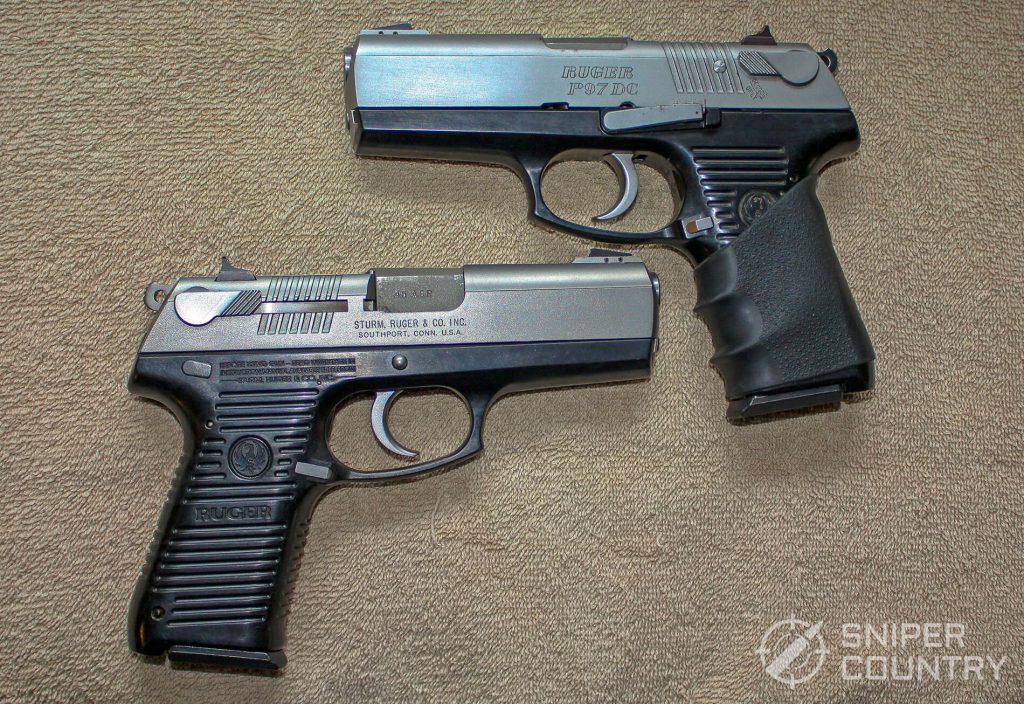
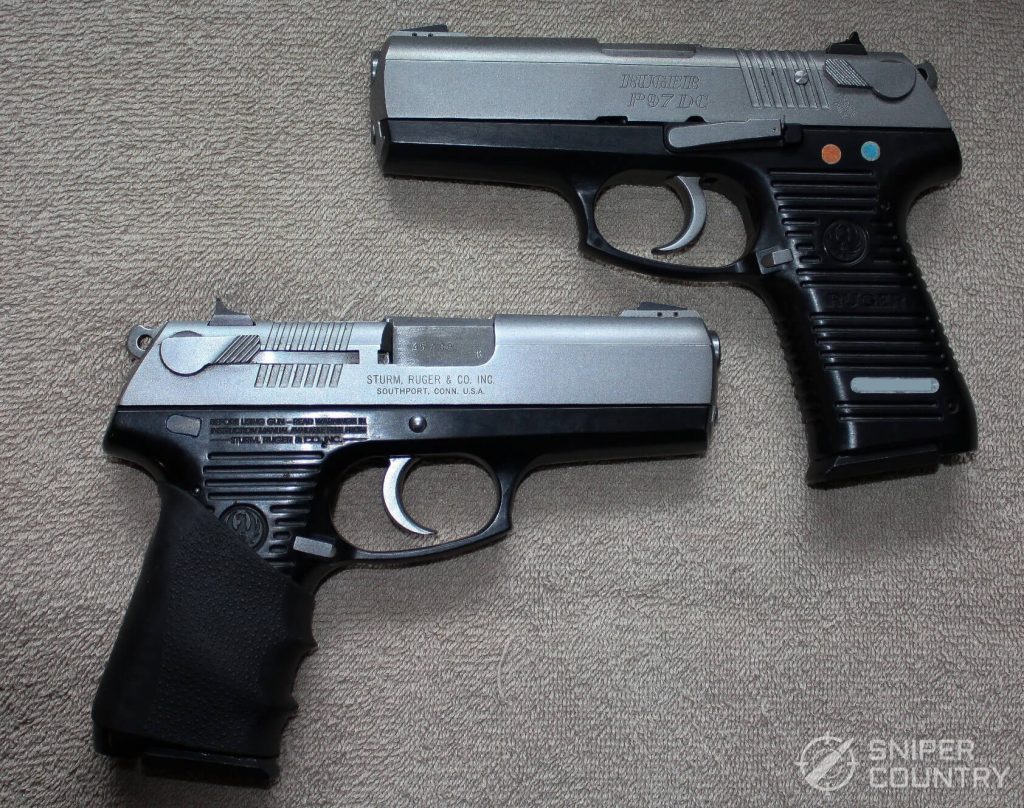
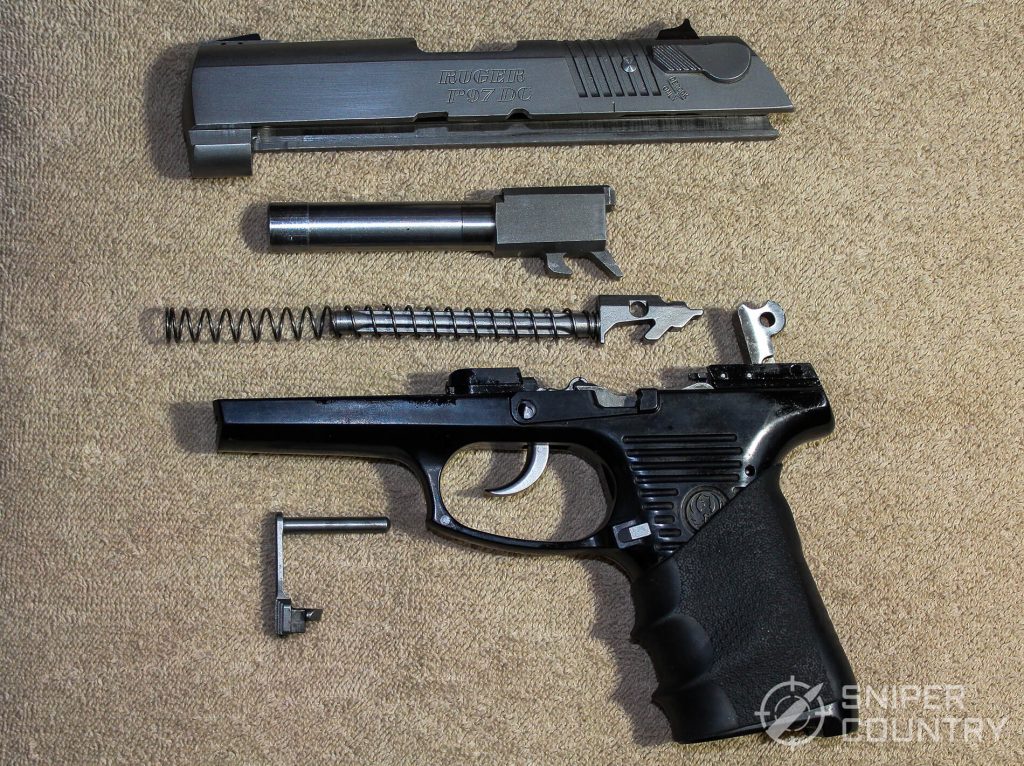
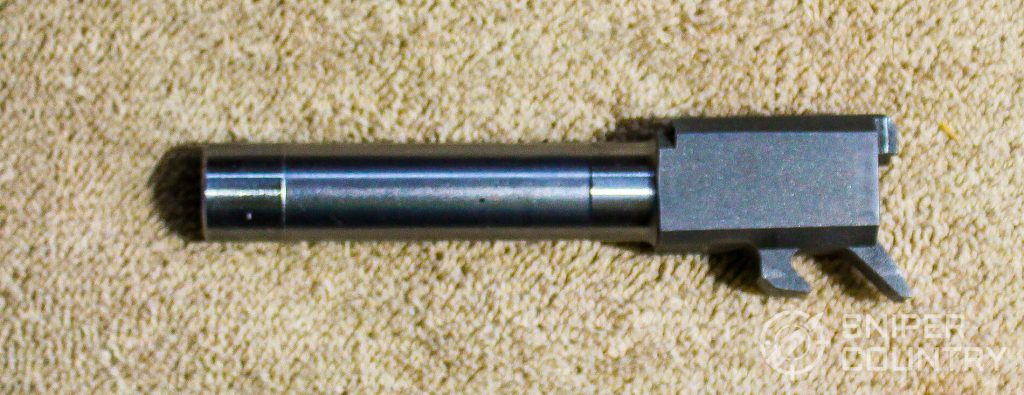
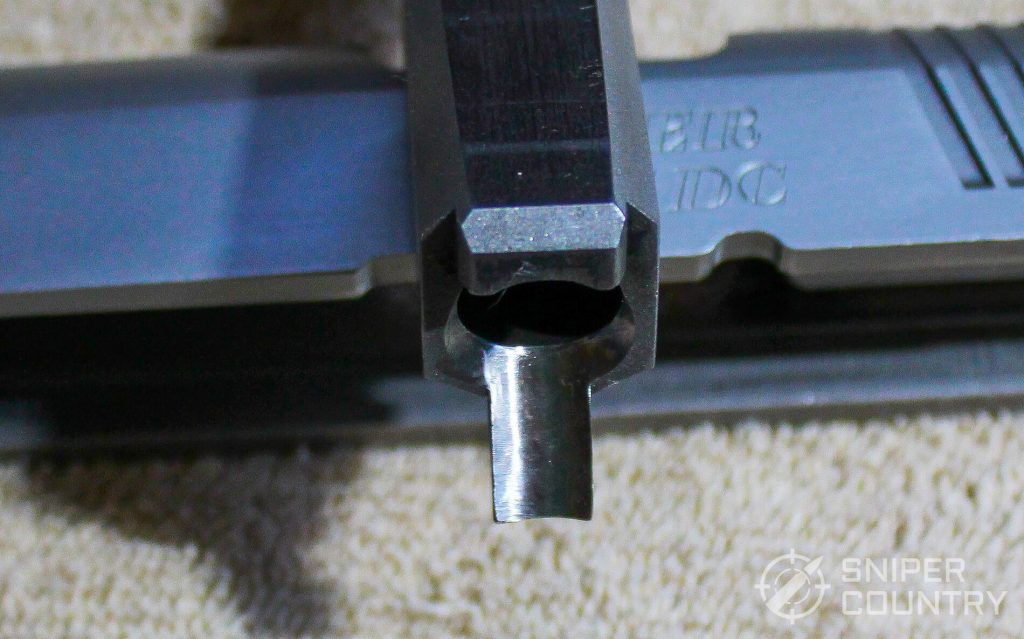
I had no problem with feeding, even with my cast 200-grain bullet handloads
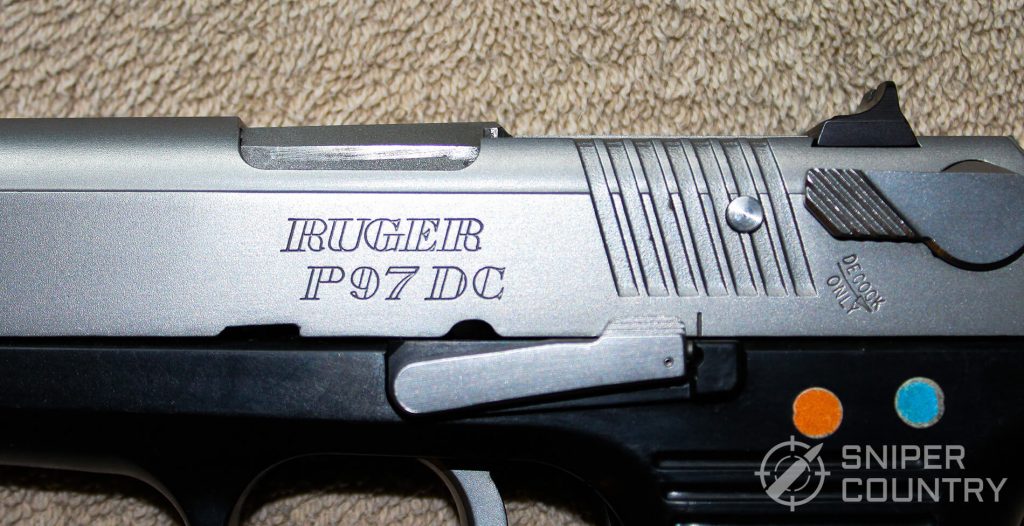
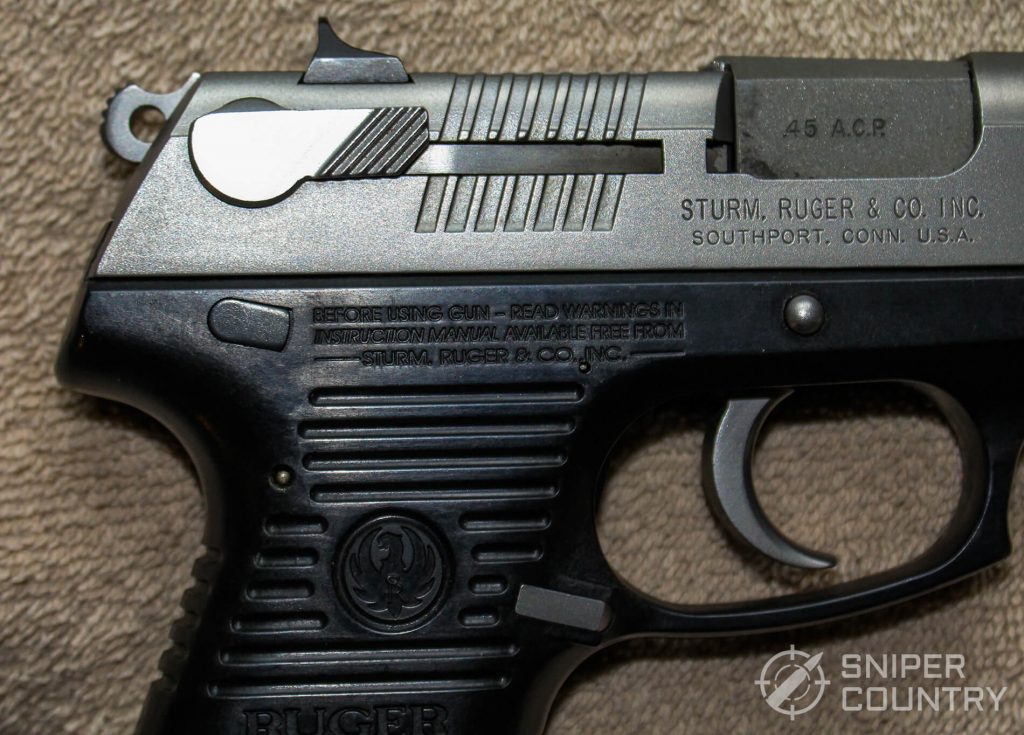
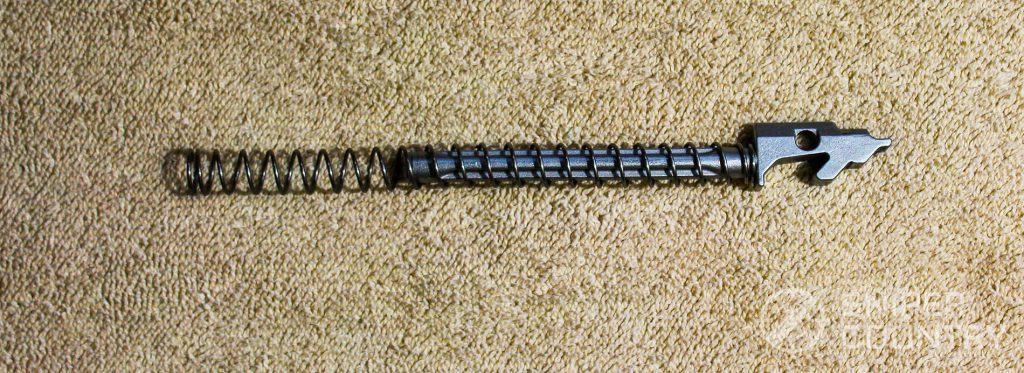
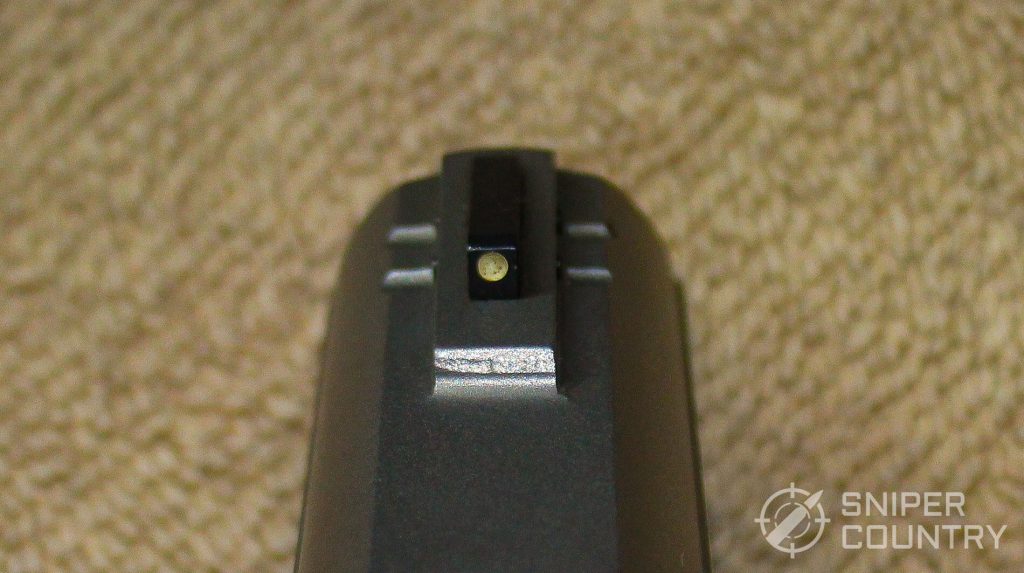
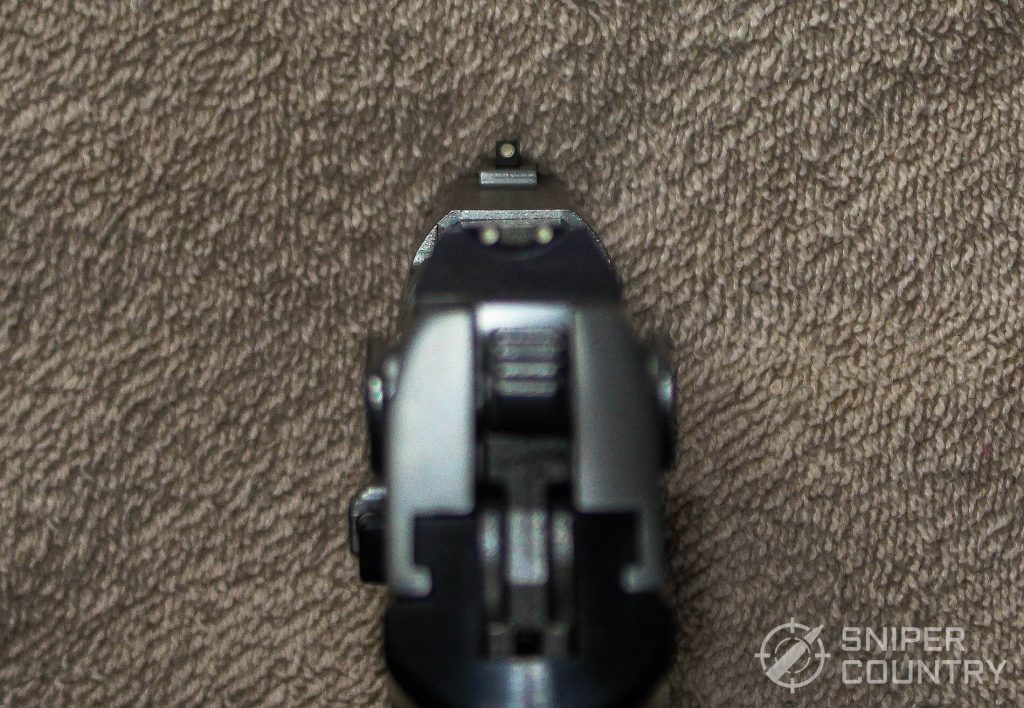
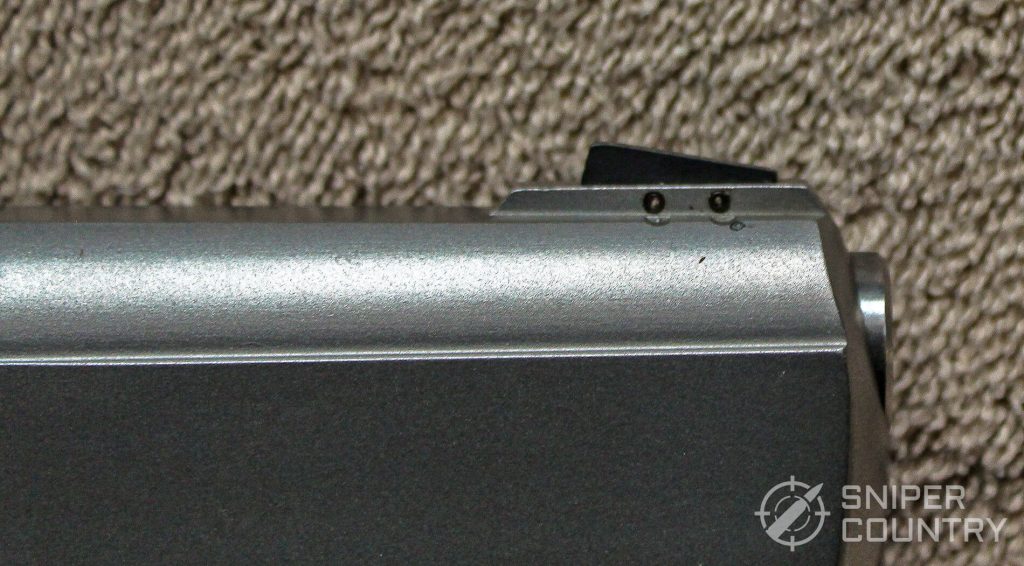
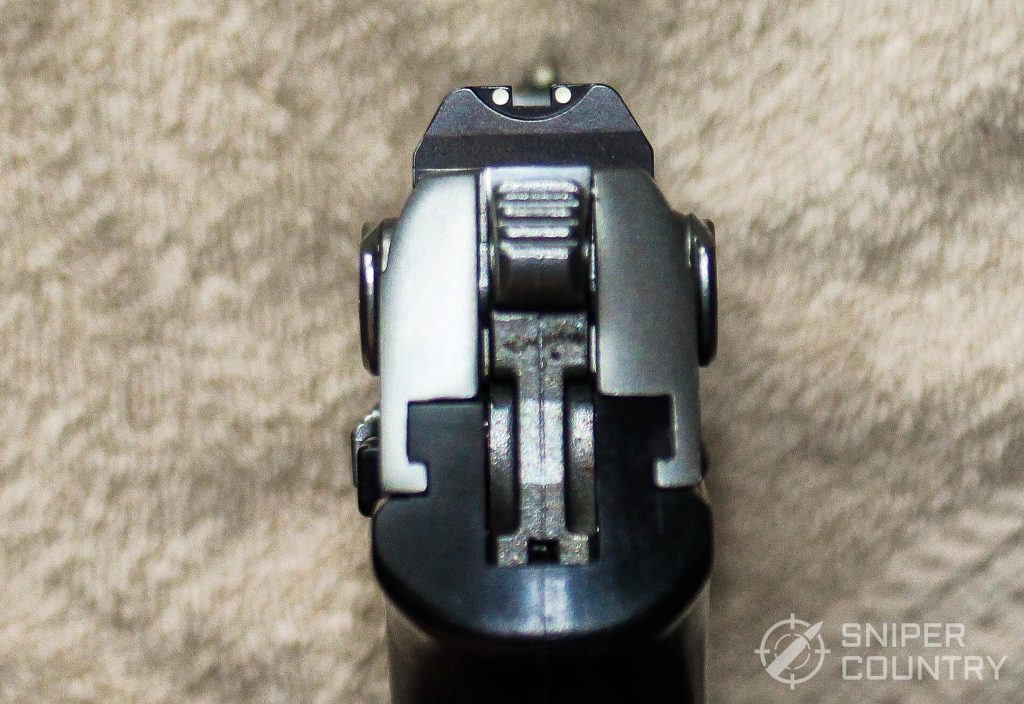
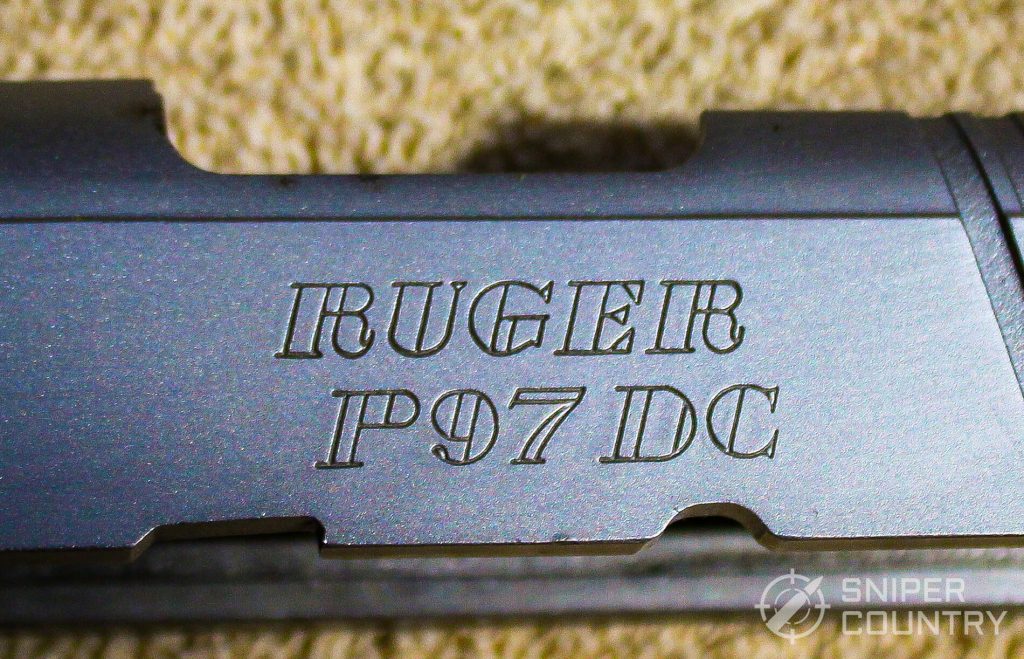


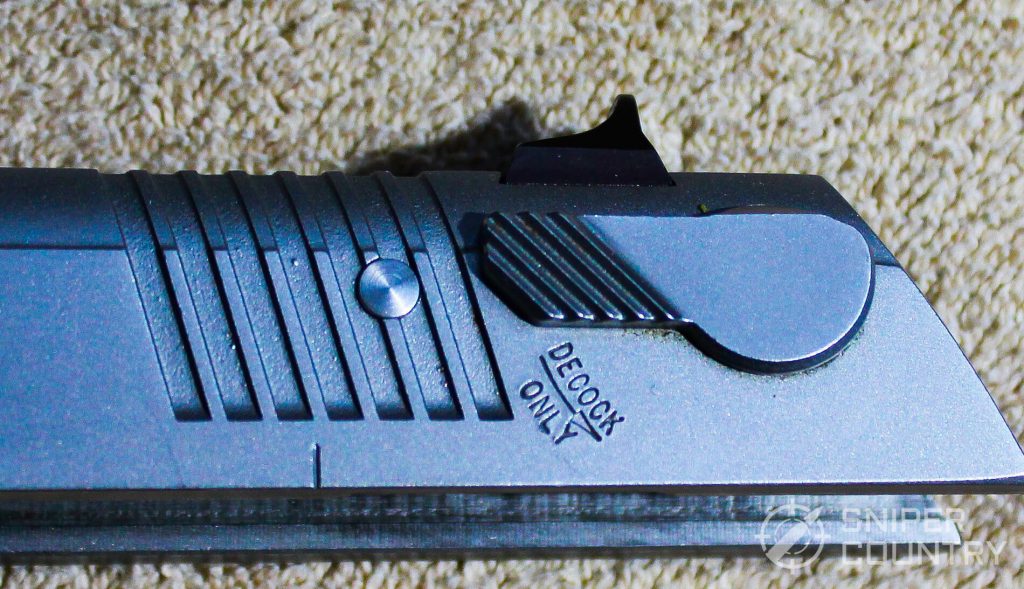
Popular Articles
Taking The P97 Apart
We all field-strip our pistols to clean them after we shoot them, each and every time – right? OK, so sometimes we don’t take them down to components but we will spray some solvent in the gun’s general direction, at least. For those who are inveterate cleaners (my hand goes up), here’s how to take this puppy apart…
1. Make sure the gun is totally free of ammo (I know, this is obvious but I once put a 230-grain cast .45 bullet in my workbench, ostensibly from a totally-unloaded gun…some guns WILL fire when you pull the trigger to remove the slide. Be warned! I now triple-check things, hoping to keep my workbench, and my person, free from extraneous holes). Remove the magazine.
2. Lock the slide back and move the ejector plate down:
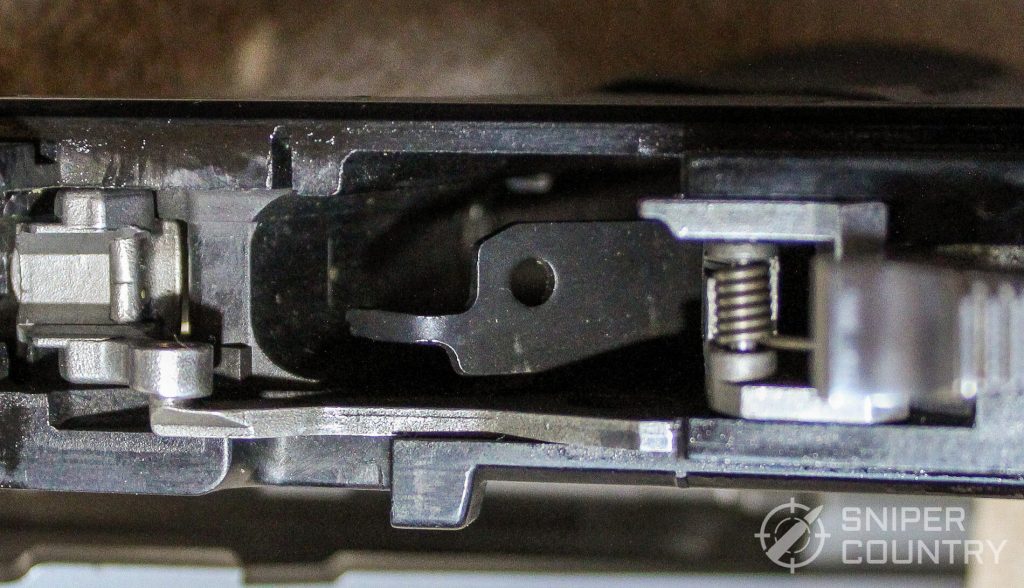
3. Pull the slide back and align the two small marks – one on the slide, one on the frame – Kahr-style:
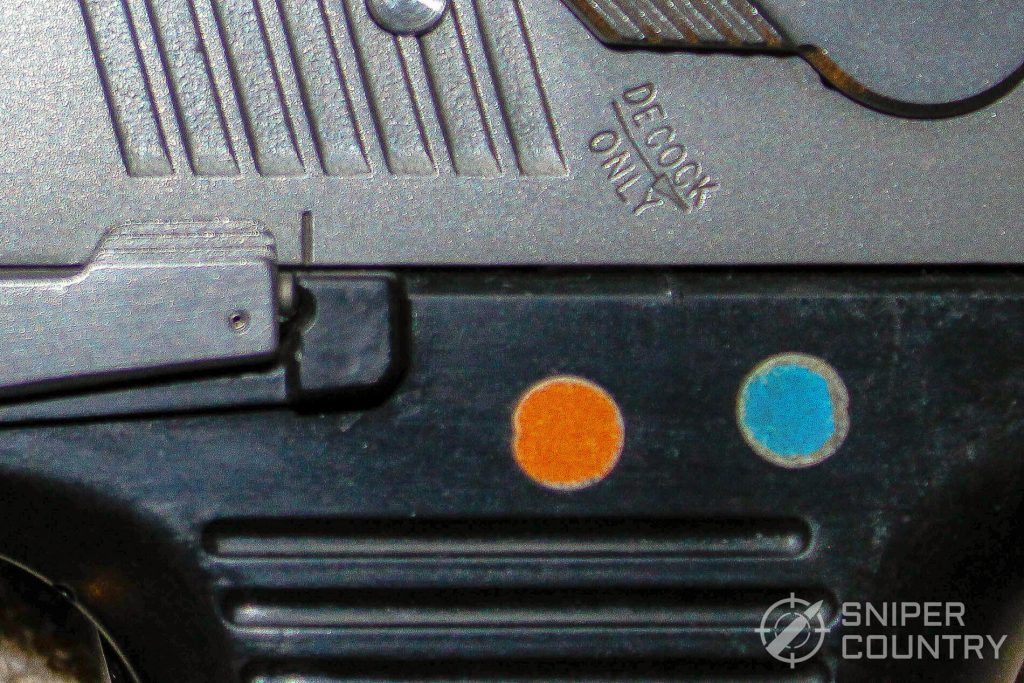
4. Push the slide stop/release lever out.
5. Remove the slide by sliding it off the frame – shouldn’t require a trigger pull.
6. Pull the recoil spring and rod out.
7. Remove the barrel.
Here, again, are the parts:

Re-Assembly
Normally, I would just tell you to re-assemble the gun in reverse order of takedown, but I ran into a bit of a glitch when I was trying to get the thing back together. Notice the recoil spring guide rod’s shape – how the end of it has a “slotâ€, for lack of a better word? That slot fits into the barrel’s corresponding lug. (It doesn’t help that I photographed the recoil spring and rod upside down – the rod really does mate with the barrel).
You next need to put the recoil spring/rod in its place in the slide. You push the spring towards the front of the slide, into its hole under the barrel opening. I couldn’t get that done, using my hands. I think my problem is simply hand strength…once upon a time, I was good for over 125 pounds of hand strength, but not so much anymore. I watched younger You Tubers simply press the un-captured spring and rod back into the hole in the front of the slide by sliding it in…I had to resort to Vice-Grips. Once I really had a good hold on the guide rod, it was a piece of cake to get it back into position. This makes me really appreciate captured recoil springs.
But…that led to another problem…I’ll stick the photo of the ejector plate here again to help explain. I was re-assembling both of the guns after cleaning them, and then ran into a problem with Tweedledee – the other one went back together with no problems.
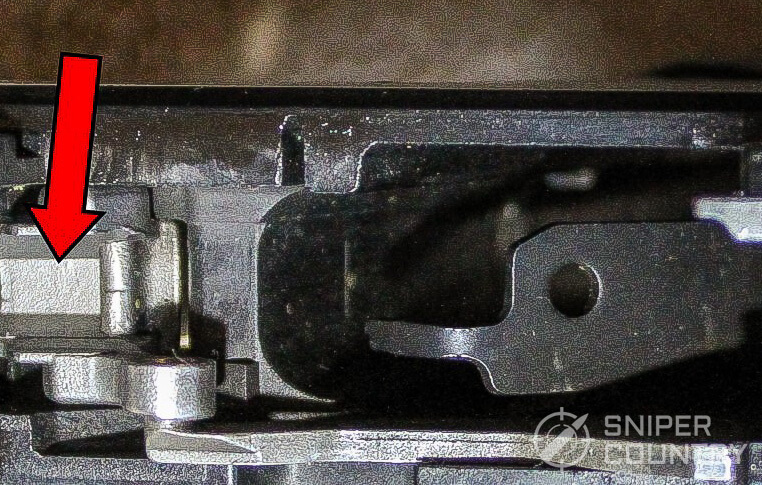
Look at the very far left side of the photo. See the trigger plate (arrow)? This plate must be as far down as you can get it – found that out the hard way. (I could not find this plate in any exploded drawing of the P97 that I checked, so I’ll stick with my nomenclature). Here’s why that little plate matters, as I found out when I could not get the slide back on past an inch or so. Evidently, this plate got moved up a bit by the connected trigger bar when I was jiggling things around, taking it apart. I could hear the slide hitting something as I tried to replace it – it was hitting this plate. Once that plate was down and seated, the slide went on as easily as it had come off.
Now, if I owned these guns, I most probably would have figured the takedown/re-assembly drill out long ago, but they were new to me in terms of takedown. I’d shot P-guns before but never had to take one apart. It isn’t hard if you make sure all the parts are in their proper place before re-assembly. If all else fails, download or look at the Ruger owner’s manual here.
BONUS OFFER: Get your free shooting range targets to print at home!
Get your free targets to print at home!
Shooting The Tweedles
I shot both guns. I used some inexpensive factory 230-grain FMJ ball and my favorite .45 ACP handload, a 200-grain semi-wadcutter over 5.3 grains of either 231 or HP38 (same stuff). Make sure to also check out my article on the best .45 ACP ammo.
Here are some targets…again, I am not the best shot in the world but the guns were fun to shoot. I shot them off my backyard bench at 25 yards.
First, Tweedledee:
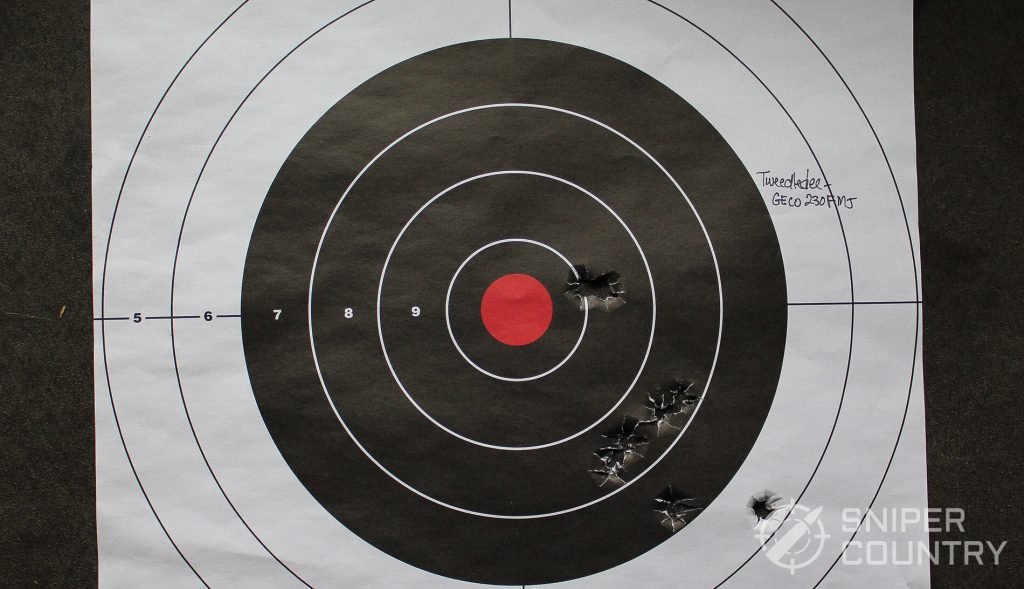
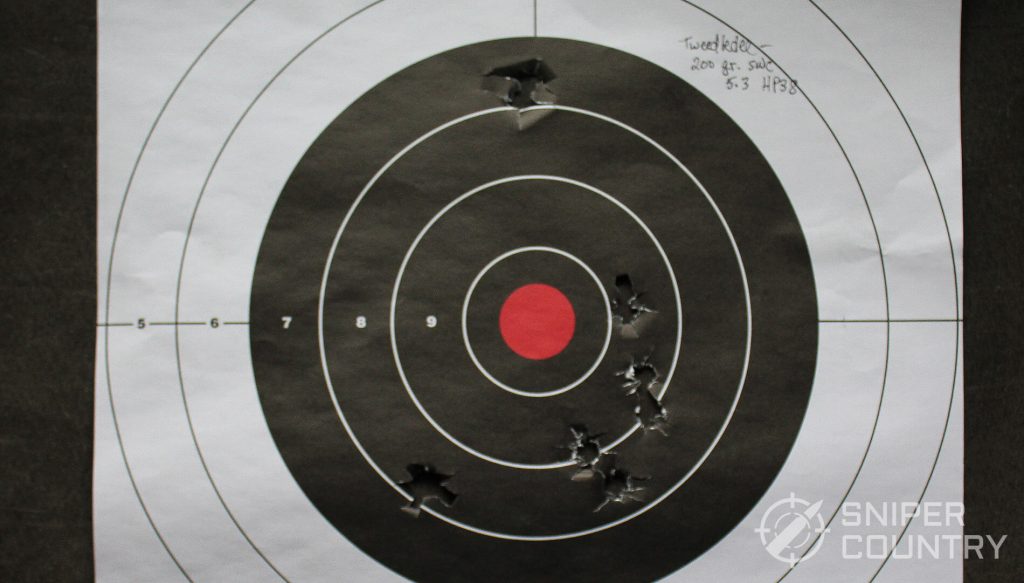
Now, Tweedledum…
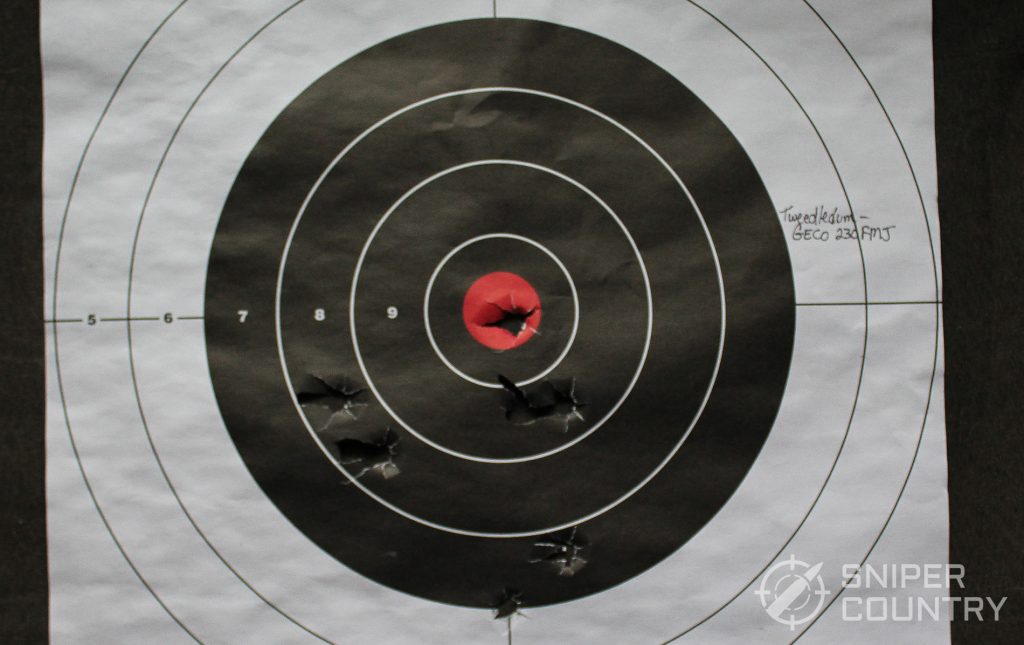
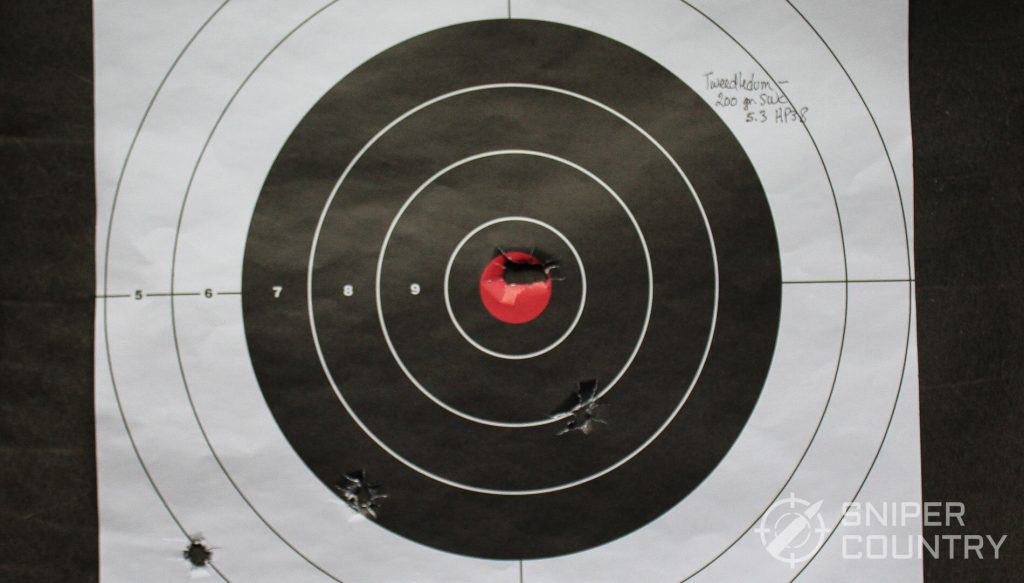
What conclusions can we draw from these targets other than I’m not a very good shot? Well, it isn’t exactly statistically accurate, but it seems that both guns were pretty much equal shooting the factory load. The handload was evidently a little more accurate when shot from Tweedledee. I stress that these targets represent only what I did on that day, with these four particular paper targets…if I were to go back out now and re-do it, the results might well be different. (Hopefully better!). If I were you, valued reader, I would not read too much into the accuracy or lack thereof shown here. Ruger guns (at least in my experience) have always been more than accurate enough for whatever task I chose to use them for so I don’t put too much emphasis on these particular results. As you have read ad nauseum online, your mileage may vary.
Conclusions
The Ruger P-series guns were, and evidently still are, popular. My friend who loaned these guns to me was so impressed he bought two of them. Even though they didn’t make it into the holsters of our military on a large scale, they have sold very well to law enforcement and civilians.
If you are looking for an older, full-size DA/SA 9mm, .40 S&W or .45 ACP pistol with a decocker, check out the corresponding-caliber P series guns. The triggers were both very good (best trigger pull gauge), the sights eminently usable and the factory customer service proven (by me) excellent. Ruger has sold thousands of these guns for good reason. Even if you only buy one, I think you could surely do worse. You don’t need both a Tweedledee and Tweedledum in order to have a good time at the range…buy one and go shoot it! (You too can give it a name if you wish). Feel free to leave a comment below if you own one of these guns in any caliber. As always, shoot often and stay safe!

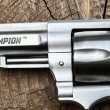
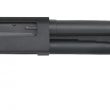


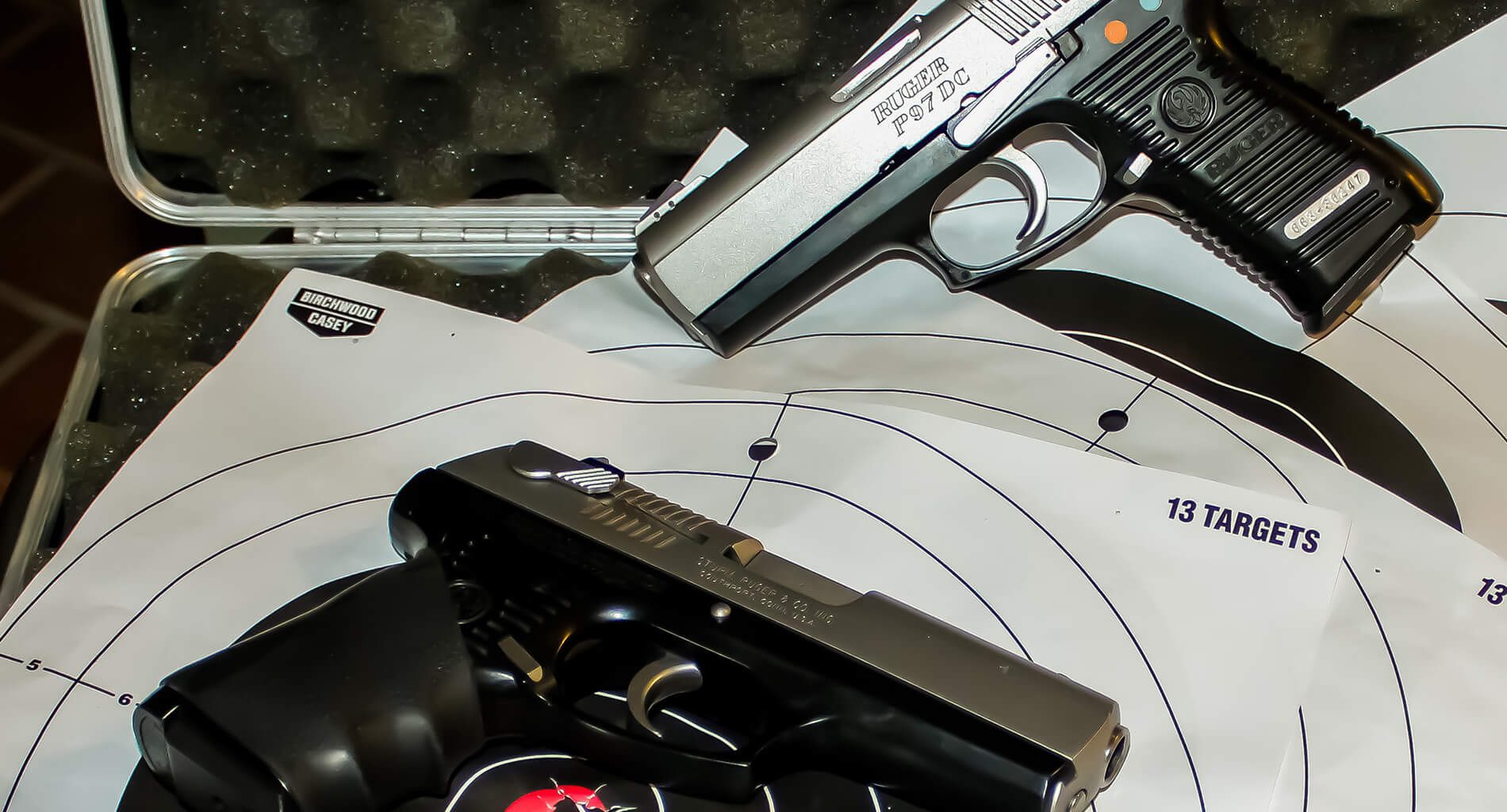
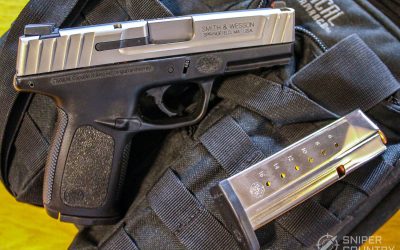

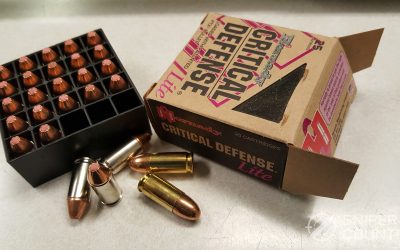

![9mm Glock Models [Ultimate Guide]](https://www.snipercountry.com/wp-content/uploads/2018/10/Glock-17-vs-Glock-19-vs-Glock-26-vs-Glock-41-vs-Glock-43-WM-400x250.jpg)
![Handgun Caliber Chart [2025 Ultimate Guide]](https://www.snipercountry.com/wp-content/uploads/2018/10/Handgun-Caliber-Comparison-400x250.jpg)
![Rifle Calibers [Ultimate Guide]](https://www.snipercountry.com/wp-content/uploads/2018/12/Header-1900-400x250.jpg)

